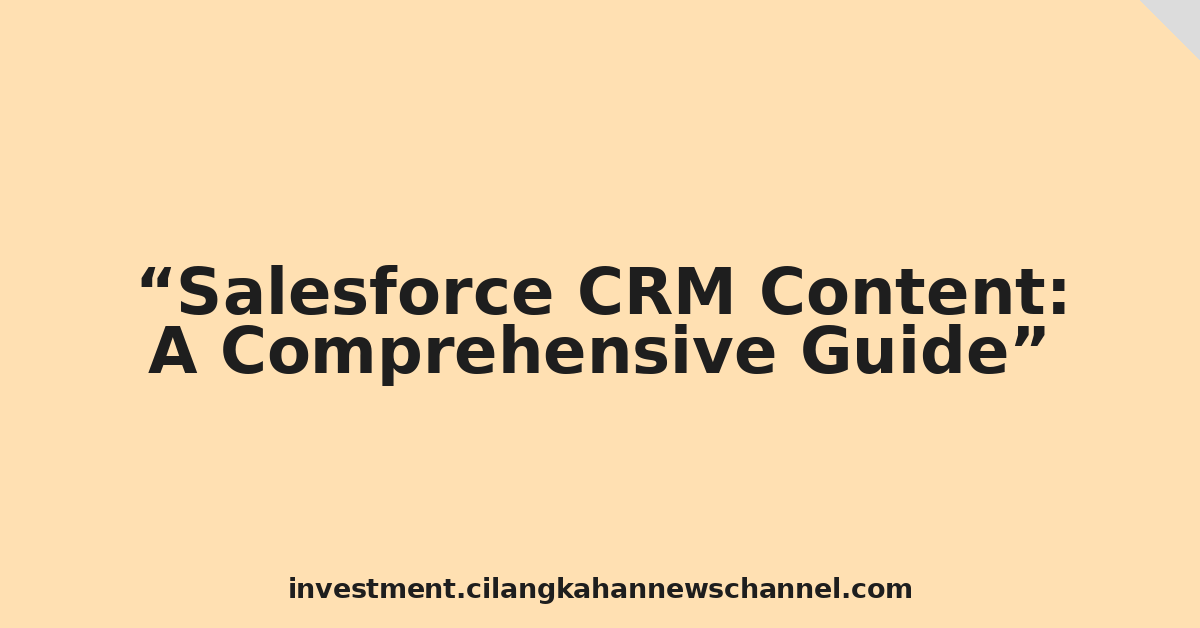Salesforce, the world’s leading Customer Relationship Management (CRM) platform, offers a vast ecosystem of tools and resources to help businesses manage customer interactions, streamline sales processes, and improve overall efficiency. Understanding Salesforce CRM content is crucial for maximizing its potential and achieving significant business growth. This comprehensive guide delves into the various aspects of Salesforce CRM content, exploring its features, benefits, and best practices for effective implementation and management.
Hello Reader, investment.cilangkahannewschannel.com. Navigating the complexities of Salesforce can feel overwhelming, especially when dealing with the sheer volume of content available. This article aims to demystify the subject, providing a clear understanding of what constitutes Salesforce CRM content and how you can leverage it to drive success. We’ll cover everything from understanding the different types of content to best practices for creation, management, and optimization.
What is Salesforce CRM Content?
Salesforce CRM content encompasses all the information and materials used within the Salesforce platform to interact with and manage customers. This includes a wide range of assets, such as:
-
Sales Collateral: Brochures, presentations, case studies, white papers, data sheets, and other marketing materials used to engage prospects and close deals. This content is often tailored to specific target audiences and sales stages.
-
Customer Support Documents: Knowledge base articles, FAQs, tutorials, videos, and other resources designed to empower customers to solve their own problems and reduce the burden on support teams.
-
Sales Emails and Templates: Pre-written email templates, personalized email sequences, and automated email campaigns to nurture leads, follow up with prospects, and build customer relationships.
-
Marketing Materials: Landing pages, email newsletters, social media posts, blog articles, and other content used to attract and engage potential customers. This content is often integrated with Salesforce Marketing Cloud.
-
Product Information: Detailed product descriptions, specifications, pricing details, and other information relevant to customers and sales representatives.
-
Training Materials: Internal training materials for sales representatives, customer service agents, and other employees to improve their skills and knowledge.
-
Contract and Agreement Documents: Templates and storage for contracts, agreements, and other legal documents related to customer interactions.
Benefits of Effective Salesforce CRM Content Management:
Implementing a robust strategy for managing Salesforce CRM content offers a multitude of benefits, including:
-
Improved Sales Productivity: Sales representatives have easy access to all the necessary information to close deals faster and more efficiently. This reduces time spent searching for information and increases overall productivity.
-
Enhanced Customer Experience: Providing customers with timely and relevant information improves their overall experience and strengthens brand loyalty.
-
Increased Revenue: Effective content marketing and sales collateral can lead to increased lead generation, conversion rates, and ultimately, revenue growth.
-
Better Collaboration: Centralized content repository facilitates better collaboration between sales, marketing, and customer service teams.
-
Improved Brand Consistency: Consistent messaging across all content assets strengthens brand identity and enhances customer trust.
-
Data-Driven Insights: Tracking content performance provides valuable insights into customer behavior and allows for continuous improvement.
-
Streamlined Sales Processes: Automation of content delivery and distribution streamlines sales processes and reduces manual effort.
-
Reduced Costs: Efficient content management reduces costs associated with creating, storing, and distributing content.
Best Practices for Salesforce CRM Content Management:
To maximize the benefits of Salesforce CRM content, consider these best practices:
-
Centralized Content Repository: Utilize Salesforce’s built-in features or third-party applications to create a centralized repository for all your content assets. This ensures easy access and avoids content duplication.
-
Content Version Control: Implement a version control system to track changes and ensure that sales representatives are using the most up-to-date information.
-
Content Tagging and Categorization: Use tags and categories to organize content and make it easily searchable. This improves findability and reduces search time.
-
Content Governance: Establish clear guidelines and processes for creating, reviewing, approving, and publishing content. This ensures consistency and quality.
-
Content Optimization: Optimize content for search engines (SEO) to improve visibility and attract more leads. This involves using relevant keywords and optimizing metadata.
-
Content Analytics: Track key metrics, such as download rates, engagement levels, and conversion rates, to measure the effectiveness of your content and make data-driven improvements.
-
Content Personalization: Personalize content based on customer demographics, interests, and buying behavior. This improves engagement and conversion rates.
-
Regular Content Updates: Regularly update and refresh your content to ensure it remains relevant and engaging. Outdated content can damage your brand’s credibility.
-
Integration with other Salesforce Clouds: Integrate your content with other Salesforce clouds, such as Sales Cloud, Service Cloud, and Marketing Cloud, to create a seamless customer experience.
-
Training and Enablement: Provide training to sales representatives and other employees on how to effectively use and manage Salesforce CRM content.
Choosing the Right Tools for Content Management:
Salesforce offers a variety of tools and features to manage content effectively. These include:
-
Salesforce Files: A built-in file storage and sharing solution within Salesforce.
-
Salesforce Knowledge: A knowledge base for storing and managing customer support articles and FAQs.
-
Salesforce Communities: Online communities where customers and employees can collaborate and share information.
-
Salesforce Content Builder: A tool for creating and managing personalized content experiences.
-
Third-Party Apps: Numerous third-party apps extend Salesforce’s content management capabilities, offering features like advanced search, content analytics, and automation.
Conclusion:
Effective Salesforce CRM content management is crucial for driving sales growth, enhancing customer experiences, and improving overall business efficiency. By implementing the best practices outlined in this guide and leveraging the right tools, businesses can unlock the full potential of their Salesforce investment and achieve significant returns. Remember that a well-defined content strategy, coupled with consistent monitoring and optimization, is key to long-term success. Regularly reviewing your content performance and adapting your approach based on data-driven insights will ensure your Salesforce CRM content continues to deliver value and drive results. The journey of mastering Salesforce CRM content is ongoing, and continuous learning and adaptation are essential for staying ahead in today’s competitive landscape.

